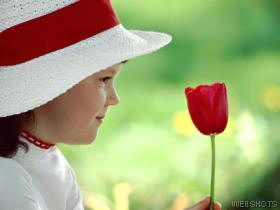Seven Wonders Of The World
Various lists of the Wonders of the World have been compiled over the ages to catalogue the most spectacular man-made constructions and natural things in the world.
The Seven Wonders of the Ancient World is the first known list of the most remarkable man-made creations of classical antiquity, and was based on guide-books popular among Hellenic sight-seers and only includes works located around the Mediterranean rim. The number seven was chosen because the Greeks believed it to be magical.
These Are The True Wonders Of The World!
To See

To See
The visual system in humans allows individuals to assimilate information from the environment. The act of seeing starts when the lens of the eye focuses an image of its surroundings onto a light-sensitive membrane in the back of the eye, called the retina. The retina is actually part of the brain that is isolated to serve as a transducer for the conversion of patterns of light into neuronal signals. The lens of the eye focuses light on the photoreceptive cells of the retina, which detect the photons of light and respond by producing neural impulses. These signals are processed in a hierarchical fashion by different parts of the brain, from the retina to the lateral geniculate nucleus, to the primary and secondary visual cortex of the brain.
To Hear

To Hear
Hearing (or audition) is one of the traditional five senses. It is the ability to perceive sound by detecting vibrations via an organ such as the ear. The inability to hear is called deafness.
In humans and other vertebrates, hearing is performed primarily by the auditory system: vibrations are detected by the ear and transduced into nerve impulses that are perceived by the brain (primarily in the temporal lobe). Like touch, audition requires sensitivity to the movement of molecules in the world outside the organism. Both hearing and touch are types of mechanosensation.
To Touch

To Touch
Touch, also called tactition, mechanoreception or somatic sensation, is the sense of pressure perception, generally in the skin.
There are a variety of nerve endings that respond to variations in pressure (e.g., firm, brushing, and sustained). The inability to feel anything or almost anything is called anesthesia.
One can feel a touch almost everywhere on one body and some results in tickling forcing a laugh or giggle. Think of the various kinds of touch.
Paresthesia is a sensation of tingling, pricking, or numbness of a person's skin with no apparent long term physical effect.
To Taste

To Taste
Taste or gustation is one of the two main "chemical" senses. There are at least four types of tastes that "buds" (receptors) on the tongue detect, and hence there are anatomists who argue that these constitute five or more different senses, given that each receptor conveys information to a slightly different region of the brain. The inability to taste is called ageusia.
The four well-known receptors detect sweet, salt, sour, and bitter, although the receptors for sweet and bitter have not been conclusively identified. A fifth receptor, for a sensation called umami, was first theorised in 1908 and its existence confirmed in 2000. The umami receptor detects the amino acid glutamate, a flavor commonly found in meat and in artificial flavourings such as monosodium glutamate.
To Feel

To Feel
To perceive or examine by touch, to have a sensation of (something), other than by sight, hearing, taste, or smell: to feel a toothache, to find or pursue (one's way) by touching, groping, or cautious moves, to be or become conscious of, to be emotionally affected by: to feel one's disgrace keenly, to experience the effects of: The whole region felt the storm, to have a particular sensation or impression of (often used reflexively and usually followed. by an adjunct or complement): to feel oneself slighted, to have a general or thorough conviction of; think; believe: I feel he's guilty, to have perception by touch or by any nerves of sensation other than those of sight, hearing, taste, and smell, to make examination by touch; grope, to perceive a state of mind or a condition of body: to feel happy; to feel well, to have a sensation of being: to feel warm, to make itself perceived or apparent; seem: How does it feel to be rich?
To Laugh

To Laugh
Laughter is an audible expression or appearance of merriment or happiness or an inward feeling of joy and pleasure (laughing on the inside). It may ensue (as a physiological reaction) from jokes, tickling and other stimuli. Inhaling nitrous oxide can also induce laughter; other drugs, such as cannabis, can also induce episodes of strong laughter. Strong laughter can sometimes bring an onset of tears or even moderate muscular pain.
Laughter is a part of human behavior regulated by the brain. It helps humans clarify their intentions in social interaction and provides an emotional context to conversations. Laughter is used as a signal for being part of a group � it signals acceptance and positive interactions with others. Laughter is sometimes seemingly contagious, and the laughter of one person can itself provoke laughter from others as a positive feedback. This may account in part for the popularity of laugh tracks in situation comedy television shows.The study of humor and laughter, and its psychological and physiological effects on the human body is called gelotology.
To Love

To Love
Love represents a range of emotions and experiences related to the senses of affection and sexual attraction. The word love can refer to a variety of different feelings, states, and attitudes, ranging from generic pleasure to intense interpersonal attraction. This diversity of meanings, combined with the complexity of the feelings involved, makes love unusually difficult to consistently define, even compared to other emotional states.
As an abstract concept love usually refers to a strong, ineffable feeling towards another person. Even this limited conception of love, however, encompasses a wealth of different feelings, from the passionate desire and intimacy of romantic love to the nonsexual. Love in its various forms acts as a major facilitator of interpersonal relationships and, owing to its central psychological importance, is one of the most common themes in the creative arts.
The Old Seven Wonders Are Even Close To The Real Ones!

The original seven wonders
